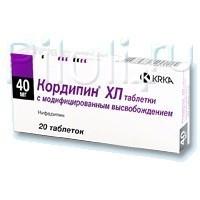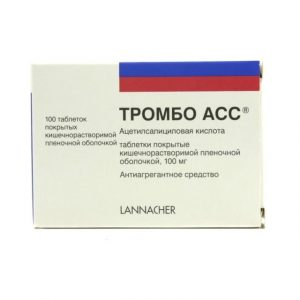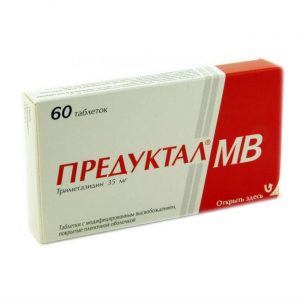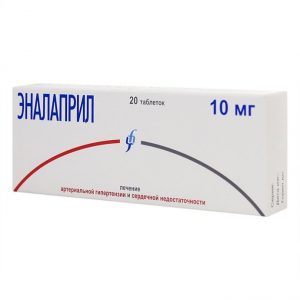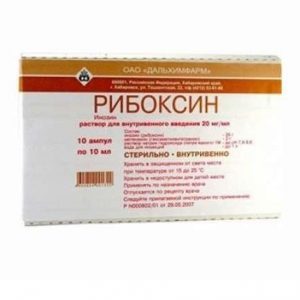Description
Release form
modified release tablets.
Packaging
20 pcs.
Pharmacological action
Cordipin ChL is a slow calcium channel blocker. It inhibits the flow of calcium ions through the membrane of the cells of the heart muscle and vascular smooth muscle. The blockade of the intake and accumulation of calcium ions inside the cells leads to the expansion of peripheral and coronary vessels, reduces OPSS, reduces afterload on the heart, reduces coronary blood flow and reduces myocardial oxygen demand.
Predominantly at the beginning of therapy, a decrease in heart rate and cardiac output due to activation of the baroreceptor reflex is possible.
With prolonged treatment with nifedipine, heart rate and cardiac output return to the values that existed before the start of therapy.
In patients with arterial hypertension, a more pronounced decrease in blood pressure is observed.
The effect of the drug lasts 24 hours, so it is enough to take it once a day.
Indications
– arterial hypertension
– stable angina pectoris (angina pectoris)
– angiospastic (vasospastic) angina pectoris.
Contraindications
– cardiogenic shock
– atrioventricular block (AV) II-III degree
– sinoatrial (SA) blockade
– syndrome of weakness of the sinus node
– severe cardiac bradycardia sardlard starda cardiac sardiac cardiac starditis hypotension (in case of use for secondary prevention of myocardial infarction – systolic blood pressure less than 100 mm Hg, heart rate less than 45 beats / min)
– lactation period
– simultaneous administration of MAO inhibitors or simultaneously ie intravenous verapamil
– up to age 18 years (effectiveness and safety have not been established)
– lactose intolerance, lactase deficiency or glucose-galactose malabsorption.
– hypersensitivity to metoprolol or other components of Metoprolol-Acre, other beta-blockers
Precautions:
diabetes mellitus, metabolic acidosis, bronchial asthma, chronic obstructive pulmonary disease (emphysema, chronic obstructive bronchitis), obliterating diseases intermittent claudication, Raynaud’s syndrome), chronic liver and / or renal failure, myasthenia gravis, pheochromocytoma (with the simultaneous use of alpha-blockers), AV blockade of I degree, thyrotoxicosis, depression (including history), psoriasis, pregnancy, old age.
malabsorption syndrome – increased sensitivity to nifedipine and other components of the drug Cordipine CL
– increased sensitivity to other derivatives of
dihydropyridine hypertension, with myocardial infarction with left ventricular failure, chronic heart failure, unstable minutes angina pectoris, obstruction of the gastrointestinal tract, in the II and III trimester of pregnancy, mild or moderate hypotension, severe cerebral circulatory disorders, disorders of the liver and / or kidney disease, hemodialysis (risk of hypotension) simultaneously with beta-blockers, cardiac glycosides, rifampicin in elderly patients.
Use during pregnancy and lactation
Prescription of the drug Cordipin ® CL in the first trimester of pregnancy is contraindicated. In the II and III trimesters, use is possible only if the intended benefit of the therapy for the mother outweighs the potential risk to the fetus.
Nifedipine is excreted in breast milk, so if you need to use the drug during lactation, you should stop breastfeeding.
Special instructions
It is recommended to discontinue treatment with Cordipin ® HL gradually.
It should be borne in mind that angina pectoris may develop at the beginning of treatment, especially after the recent abrupt cancellation of beta-blockers (the latter should be abolished gradually). The simultaneous administration of beta-blockers must be carried out under close medical supervision, as this may cause an excessive decrease in blood pressure, and in some cases exacerbate the symptoms of heart failure.
Diagnostic criteria for prescribing a drug for angiospastic angina pectoris are: the classic clinical picture, accompanied by an increase in the ST segment, the occurrence of ergonovine-induced angina pectoris or spasm of the coronary arteries, the detection of coronary spasm during angiography, or the detection of the angiospastic component without confirmation (for example, with different unstable voltage thresholds angina pectoris when ECG data indicate transient angiospasm).
For patients with severe obstructive cardiomyopathy, there is a risk of increasing the frequency, severity of the manifestation and the duration of angina attacks after taking nifedipine in this case, drug withdrawal is necessary.
In patients undergoing hemodialysis with high blood pressure and irreversible renal failure with reduced BCC, Cordipine ChL should be used with caution, because a sharp drop in blood pressure may occur.
The condition of patients with impaired liver function should be carefully monitored and, if necessary, reduce the dose and / or use other dosage forms of nifedipine.
If during treatment the patient needs to undergo surgery under general anesthesia, it is necessary to inform the anesthetist about the nature of the therapy.
During treatment, positive results are possible with a direct Coombs reaction and laboratory tests for antinuclear antibodies.
With caution, the drug Cordipine ChL should be prescribed simultaneously with disopyramide and flecainamide.
Influence on the ability to drive vehicles and control mechanisms
In some patients, especially at the beginning of treatment, the drug may cause dizziness, which reduces the ability to drive a car or other mechanisms. In the future, the degree of restriction is determined depending on the individual tolerance of the drug.
Composition
1 tab: – nifedipine 40 mg
Excipients: microcrystalline cellulose, cellulose, lactose, hypromellose (methylhydroxypropyl cellulose), magnesium stearate, anhydrous colloidal silicon dioxide.
Shell composition: hypromellose (methylhydroxypropyl cellulose), macrogol 6000, macrogol 400, iron dye oxide red (E172), titanium dioxide (E171), talc.
Dosage and administration
Install individually.
The drug Cordipine ChL is prescribed in an average dose of 40 mg (1 tab) 1 time / day. both at the beginning of therapy, and with prolonged treatment. If necessary, increase the dose to a maximum of 80 mg (2 tablets) / day. in 1 or 2 doses.
In case of skipping the next dose of the drug, the next dose should not be doubled.
Cordipine ChL should be taken after meals. The tablets are taken whole, without breaking or chewing, with a glass of water.
Side effects
From the cardiovascular system: manifestations of excessive vasodilation (asymptomatic decrease in blood pressure, facial skin, hot flashes, flushing) arrhythmia, peripheral edema, the development or worsening of heart failure (often worsening already existing), chest pain rarely – excessive decrease in blood pressure, fainting in some cases (especially at the beginning of treatment) – angina attacks (drug withdrawal is required) in isolated cases – myocardial infarction.
From the side of the central nervous system and peripheral nervous system: headache, dizziness, fatigue, weakness, drowsiness with prolonged use in high doses – paresthesia in the extremities, depression, anxiety, extrapyramidal (parkinsonian) disorders (ataxia, masky face, shuffling gait, stiffness of the movements of the arms and legs, tremor of the hands and fingers, difficulty swallowing).
From the digestive system: dry mouth, decreased appetite, dyspepsia (nausea, diarrhea or constipation) rarely – gum hyperplasia (bleeding, soreness, swelling) with prolonged use – impaired liver function (intrahepatic cholestasis, increased activity of hepatic transaminases).
From the hemopoietic organs: anemia, asymptomatic agranulocytosis, thrombocytopenia, thrombocytopenic purpura, leukopenia.
From the musculoskeletal system: arthritis rarely – arthralgia, swelling of the joints, myalgia, cramps of the upper and lower extremities.
From the urinary system: an increase in daily urine output, impaired renal function (in patients with renal failure).
From the respiratory system: rarely – difficulty breathing, cough very rarely – pulmonary edema, bronchospasm.
From the sensory organs: very rarely – visual impairment (including transient blindness with a maximum concentration of nifedipine in blood plasma).
From the endocrine system: very rarely – gynecomastia (in elderly patients, completely disappears after drug withdrawal), galactorrhea.
From the side of metabolism: very rarely – hyperglycemia, weight gain.
Allergic reactions: rarely – itchy skin, exfoliative dermatitis very rarely – autoimmune hepatitis.
Dermatological reactions: rarely – exanthema, photodermatosis.
Drug interaction
The severity of a decrease in blood pressure is enhanced by the simultaneous use of Cordipine CL with other antihypertensive drugs, beta-blockers, nitrates, cimetidine (to a lesser extent degrees – with ranitidine), inhaled anesthetics, diuretics, tricyclic antidepressants.
Medicines from the group of slow calcium channel blockers can further enhance the negative inotropic effect of such antiarrhythmic drugs, like amiodarone and quinidine.
Nifedipine causes a decrease in the concentration of quinidine in the blood plasma, after the withdrawal of nifedipine, a sharp increase in the concentration of quinidine can occur.
Nifedipine increases plasma concentrations of digoxin and theophylline (when combined, the clinical effect and plasma concentrations of digoxin and theophylline are required).
Inducers of microsomal liver enzymes (including rifampicin) reduce the concentration of nifedipine in the blood plasma
When used with nitrates, tachycardia increases.
Antihypertensive effect reduce sympathomimetics, NSAIDs, estrogens, calcium preparations.
Nifedipine is able to displace drugs with a high degree of binding from plasma protein binding (including indirect anticoagulants, coumarin and indandion derivatives, anticonvulsants, NSAIDs, quinine, salicylates, sulfinpyrazone), as a result of this, an increase in their plasma concentrations is possible.
Nifedipine slows the elimination of vincristine from the body and may cause an increase in the side effect of vincristine (with this combination, if necessary, reduce the dose of vincristine).
Lithium preparations may enhance the side effects of nifedipine (nausea, vomiting, diarrhea, ataxia, tremors, tinnitus).
With the simultaneous administration of cephalosporins (eg, cefixime) and nifedipine, the bioavailability of cephalosporin increased by 70%.
Nifedipine inhibits the metabolism of prazosin and other alpha-adrenergic blockers, as a result of which an increase in the hypotensive effect is possible.
procainamide, quinidine, and other drugs that cause a prolongation of the QT interval, enhance the negative inotropic effect and may increase the risk of a significant lengthening of the QT interval.
Grapefruit juice inhibits the metabolism of nifedipine, therefore, during the treatment with Cordipin CL its use is contraindicated.
overdose
Symptoms: drug causes peripheral vasodilation with severe and possibly prolonged arterial hypotension: headache, facial skin hyperemia, prolonged severe decrease in BP, inhibition of sinusocardium activity. In severe poisoning – loss of consciousness, coma.
Treatment: standard measures aimed at removing the drug from the body (the appointment of activated carbon, gastric lavage), stabilization of hemodynamics, careful monitoring of the heart, lungs and excretory system.
Antidotes are calcium preparations. Shown in / in the introduction of a 10% solution of calcium chloride or calcium gluconate, followed by switching to prolonged infusion.
Due to the high degree of binding to blood plasma proteins, hemodialysis is not effective.
It is recommended to monitor blood glucose (may reduce insulin release) and electrolytes (potassium, calcium).
Nifedipine clearance is increased in patients with impaired liver function.
Storage Conditions
In a dark place at a temperature not exceeding 25 ° C.
Shelf life
3 years.
Deystvuyushtee substance
Nifedipine
Terms and conditions
Prescription
Dosage form
tablets prolong.
Possible product names
Cordipin XL tab. 40mg N20 Slovenia
CORDIPIN XL 0.04 N20 TABLES
CORDIPIN XL 0.04 N20 TABLES P / O WITH EMPTY MODIF
CORDIPIN XL 40MG. No. 20 TAB. / KRKA /
CORDIPIN XL TABL.P.O.S WITH MODIF. 40MG N20
KRKA d.d. Novo mesto AO, Slovenia
